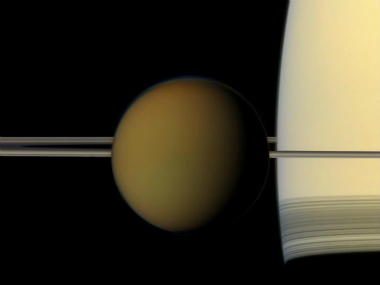Washington: Nasa’s Cassini spacecraft has spotted a mysterious ice cloud over Saturn’s largest moon, Titan, and its appearance challenges everything known about the moon’s atmosphere. The puzzling appearance of the ice cloud has prompted Nasa scientists to suggest that a different process than previously thought - possibly similar to one seen over Earth’s poles - could be forming the clouds. [caption id=“attachment_3015468” align=“alignleft” width=“380”] The hazy globe of Titan hangs in front of Saturn and its rings in this natural colour view from NASA’s Cassini spacecraft. (Photo: NASA/JPL-Caltech/Space Science Institute)[/caption] Located in Titan’s stratosphere, the cloud is made of a compound of carbon and nitrogen known as dicyanoacetylene (C4N2), an ingredient in the chemical cocktail that colours the giant moon’s hazy, brownish-orange atmosphere. Decades ago, the infrared instrument on Nasa’s Voyager 1 spacecraft spotted an ice cloud just like this one on Titan. What has puzzled scientists ever since is that they detected less than one per cent of the dicyanoacetylene gas needed for the cloud to condense, Nasa said. Using Cassini’s composite infrared spectrometer, or CIRS, researchers found a large, high-altitude cloud made of the same frozen chemical. Just as Voyager found, when it comes to the vapour form of this chemical, CIRS reported that Titan’s stratosphere is as dry as a desert, Nasa said. “The appearance of this ice cloud goes against everything we know about the way clouds form on Titan,” said Carrie Anderson, a CIRS co-investigator at Nasa’s Goddard Space Flight Centre and lead author of the study. The typical process for forming clouds involves condensation. On Earth, we are familiar with the cycle of evaporation and condensation of water. A different condensation process takes place in the Titan’s stratosphere - the region above the troposphere - at the moon’s north and south winter poles. In this case, layers of clouds condense as the global circulation pattern forces warm gases downward at the pole. The gases then condense as they sink through cooler and cooler layers of the polar stratosphere. Either way, a cloud forms when the air temperature and pressure are favourable for the vapour to condense into ice. The vapour and the ice reach a balance point - an equilibrium - that is determined by the air temperature and pressure. Because of this equilibrium, scientists can calculate the amount of vapour where ice is present. “For clouds that condense, this equilibrium is mandatory, like the law of gravity,” said Robert Samuelson, scientist at Goddard. However, the numbers do not compute for the cloud made from dicyanoacetylene. The scientists determined that they would need at least 100 times more vapour to form an ice cloud where the cloud top was observed by Cassini’s CIRS. Instead of the cloud forming by condensation, they think the C4N2 ice forms because of reactions taking place on other kinds of ice particles. Researchers call this “solid-state chemistry,” because the reactions involve the ice, or solid, form of the chemical. The findings were published in the journal Geophysical Research Letters.
Nasa’s Cassini spacecraft has spotted a mysterious ice cloud over Saturn’s largest moon, Titan, and its appearance challenges everything known about the moon’s atmosphere.
Advertisement
End of Article


)

)
)
)
)
)
)
)
)



